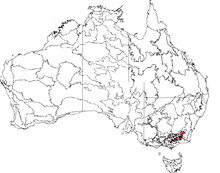Ngarigo people and Ngarigo: Difference between pages
+infobox ATSI groups |
No edit summary |
(No difference)
| |
Revision as of 11:43, 21 April 2015
| Dunghutti people | |
|---|---|
| aka: Ngarigo (language name), Ngarego, Ngarago, Garego, Currak-da-bidgee, Ngarigu, Ngarrugu, Ngarroogoo, Murring ("men"), Bemeringal (by coastal tribes "mountain man"), Guramal, Gurmal (by Wiradjuri), Bradjerak (by southern coastal tribes), Bombala tribe, Menero tribe, and Cooma tribe (AIATSIS), nd (SIL)[1] | |
 | |
| Hierarchy | |
| Language family: | Pama–Nyungan |
| Language branch: | Yuin–Kuric |
| Language group: | Yora |
| Group dialects: | Ngarigu[2] |
| Area | |
| Location: | Monaro and Australian Alpine regions of New South Wales and Victoria |
| Rivers | |
| Urban areas |
|
| Notable individuals | |
The Ngarigo are an Aboriginal group whose traditional lands lie in the Monaro and Australian Alpine regions of New South Wales and Victoria, south-east of the Canberra area.[3][4]
According to anthropologist Norman Tindale in his 1974 catalogue of Australian Aboriginal people groups, the specific areas lands of the Ngarigo are:[5]
the Monaro tableland north to Queanbeyan; Bombala River from near Delegate to Nimmitabel; west to divide of the Australian Alps. The Wiradjuri considered the Ngarigo and Walgalu as one people using the name Guramal which has the basic meaning of ['gurai] or 'hostile people.' Canberra, the capital city of the federal capital territory is very close to the boundary line between this and the Ngunawal tribe. In winter these tableland people sometimes came down to the surrounding territories for shelter, hence their reputation for aggressiveness.
The Cooma government web site states that "the two main groups on Monaro were the Ngarigo people of the tablelands and the Wogul or Wolgalu group in the high country."[6]
The Ngarigo people spoke the Ngarigu language and a southern dialect, southern Ngarigu, which were used as far south as Goongerah in Victoria.[7]
References
- ^ Dousset, Laurent (2005). "Ngarigo". AusAnthrop Australian Aboriginal tribal database. Retrieved 21 April 2015.
- ^ "Language information: Ngarigu". Australian Indigenous Languages Database. AIATSIS. 26 June 2012. Retrieved 21 April 2015.
- ^ Gillespie, Lyall (1984). Aborigines of the Canberra Region. Canberra: Wizard (Lyall Gillespie). pp. 1–25. ISBN 0-9590255-0-2.
- ^ Tindale, Norman (1974). "Thaua". Catalogue of Australian Aboriginal Tribes. South Australian Museum.
the Bemerigal or mountain people at Cooma belonged to the Ngarigo
- ^ Tindale, Norman (1974). "Ngarigo (NSW)" (reproduction). Aboriginal Tribes of Australia. South Australian Museum.
- ^ Aboriginal People of Monaro, Cooma-Monaro Shire Council
- ^ Clark, Ian D. (25 August 2005). "Aboriginal Language Areas in Victoria – a reconstruction" (PDF). A Report to the Victorian Aboriginal Corporation For Languages (PDF). Retrieved 10 September 2011.
